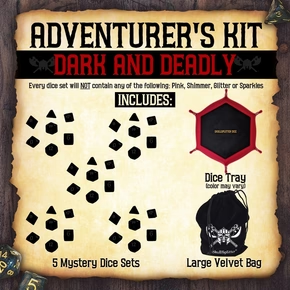
A DM’s Guide to Running Spelljammer and Other Spacefaring Adventures
From Starfinder to Spelljammer, there are infinite adventures waiting for your players beyond the stars. It's not all glorious space operas though, there's a few blackhole-sized pitfalls that can leave your interstellar campaigns adrift in the void. By following just a few tips you can keep your campaign in orbit instead of going supernova. Take an abyssal trip through the vacuum of space with us as we go through everything you need to know.
Table of Contents:
Space Campaign Worlds
Ever since Advanced Dungeons & Dragons introduced us to spelljammer, the "sci-fi" adventure has been a popular campaign setting for various systems. Space can be a bleak realm showcasing the dangerous depths of wildspace, or it can be a fun Buck Rogers style affair showcasing the assorted races of alien worlds and the poetic approach to a classic space opera. However you run with it, space and science fiction make for prime campaign material and a great change of pace from a default campaign setting. They can be tricky though, mainly regarding how you handle space travel and how much freedom you really afford your players. The universe is a big place and it's impossible to have a whole universe of content ready for your players at any time. Using campaign books and established settings is a good place to start so let's go through some of the most popular established space settings.
Spelljammer
The spelljammer universe is an old beloved D&D setting that doesn't have an official 5e version yet (and is just one part of the D&D multiverse), but it's such an intriguing setting I couldn't help but give it a recommendation. If you've never seen anything about it, remember the Disney film “Treasure Planet”? It's like that, high fantasy in space with pirate ships sailing between fantastical planets. There are a few homebrews for more modern systems in the spelljammer campaign setting (or there's always the original) and it's one of the best ways to adventure among the stars. 5th edition doesn't currently have any content for spelljammer, but we're very likely to get it in the near future. Recent unearthed arcana articles included several notable playable races from the spelljammer setting, including the astral elf, the plasmoid amorphous race, the giff humanoid hippos, and the hadozee apelike race.
Starfinder

Starfinder is for better or worse, Pathfinder in space. If your playgroup knows pathfinder and likes pathfinder than Starfinder is your logical choice for taking your adventures into the stars. It's complicated, there's a rule for every eventuality and it's got a TON of player options. It has a major departure from pathfinder with the resolve and stamina system, but beyond that, veteran pathfinder players will take to it easily. If you're not a fan of pathfinder, you won't be a fan of Starfinder (but if you are it's perfect).
Star Wars: Edge of Empire
While it does wear the Star Wars branding, it's a beautifully designed system that can be used for any spacefaring campaign that you can come up with. Star Wars takes a major diversion from most TTRPGs with its own special set of dice. You can technically do without these dice (there's an easily available die translator online, which is a weird thing to say), but you'll still likely need a set or two. These custom dice allow them to do some very innovative and creative things, but it takes some getting used to. It's worth it though if you and your playgroup are willing to learn a strikingly different system from D&D.
The Vast Emptiness of Space
The universe is filled with quite literally endless possibilities for your campaign. Your players will be able to traverse the final frontier and boldly go to entirely new worlds. Which makes it odd that the most common problem I've encountered with games involving space travel is a harsh feeling of railroading and lack of options. Spacefaring campaigns have very similar problems to those encountered in seafaring campaigns, in that your players become beholden very clearly to what you choose to put in their path. This is technically true of any setting, but it comes directly to the forefront when traversing the stars.
Imagine a scenario in which your band of space adventurers needs to fly their ship from a space station to a specific planet to track down a wanted assassin on a star voyage that will take a week. You've presented a plothook in the form of the assassin and the direction in the form of the planet. Your players suit up, liftoff, and… fly directly there. No interesting side-quests, no diversions. The players will simply spend a week going from point A to point B. You can throw some interference in the way, maybe space pirates attack or maybe there's a radiation storm, but in the end, that'll just be exactly that, interference on the way from point A to point B.
Now imagine the scenario in a traditional fantasy setting, your band of guild adventurers need to travel to a far-off city to track down a wanted assassin, the trip on horseback will take a week. You've again presented a plothook in the form of the assassin and the direction in the form of a city. Your players suit up, ride out, and… are immediately faced with choices. Do they go around the mountains or over them, or even under them? Do they take a shorter route through orc-controlled territory, or do they take the long way around through the woods? Every fork in the road provides your players with real choices they can make along the way, and really change the adventure because of it. This is the player agency that so many spacefaring campaigns end up missing, but they don't have to.
All those choices can be reproduced in a sci-fi setting. Firstly, while making a whole star-chart gets wonky (3 dimensions and all) you can do a lot by establishing a “course” that your player's journeys will take. It doesn't have to be extensive, but something as simple as “you'll have to go around or through this dangerous nebula” and “you'll pass by this planet, do you want to stop for supplies?” can give your players the gameplay agency they'll end up missing otherwise.
On that note, I highly encourage limiting the fuel, supplies, or some other resource that your player's have available. Let's go back to our space adventurers and their wanted assassin. They have a week of travel to reach their target and 2 weeks' worth of fuel to get there. But heading straight there would cut right through a radioactive nebula and a wide swath of space pirate territory. Going around would take a week and a half, could get dicey, but maybe they'll stop at a neighboring moon base to refuel (that just so happens to be embroiled in a mutiny), or decide to take a risk refueling at the old smuggler's asteroid. Half-way they can receive a distress call from a mysterious source a day's warp out, Is it worth the detour? The distorted message mentions some reward… I don't advocate limiting their fuel and supplies to the point that it becomes crippling, but some loose limits can change a simple “push button then arrive” narrative into an honest adventure, making life or death decisions as you chart a course between the stars.
Empty is Boring, Fill Up Your Universe!

Endless possibilities is nice to say, but you as the GM still need to plan an adventure! Think back to some noted space adventure flops like “Spore” or “No Man's Sky” (yes I know it got better after patches), they promised near-infinite space adventure but they were both filled with just mostly empty repeating worlds. This is important to keep in mind whether you're going into an established space setting (like Starfinder or Spelljammer) or making your own new setting.
It's great encountering new unknowns out in space but you need a narrative thread that links your adventures together.
Give your players some context for the star faring environment around them. Are you limited to a single star system? Then really flesh out those worlds to start with, give them a strong basis to build their characters out from and a perspective to be shocked by the mysteries of the universe.
Is your setting at a galactic or even intergalactic scale? Then who are the major powers on the intergalactic stage? What struggles are sweeping across the cosmos and what threats loom out from the stellar abyss?
You don't have to fill in every corner of the star chart, and in fact you shouldn't. But I highly recommend establishing a full background beyond “endless possibilities”.
Starfighting
Without going into TOO much detail because of the wide variety of systems available (there's a ton to pick from) there's a good chance that your spacefaring campaign will have some high-octane ship combat. Just like in a seafaring adventure, once your players take roles on a ship, they often lose a ton of autonomy. Unlike in a dungeon delve, players don't get to really utilize their characters. All those class and race features, all those things they tried to tie together to make their character unique often get boiled down into one stat or two as they control just one or two of the ship's functions.
Without going into rules minutia, there's a couple ways to solve this. If you find that your players are getting bored during what should be exciting space battles, then try bringing their actual characters to the forefront. Try using boarding parties or infestations of aliens WHILE the star fighting is taking place. Imagine your players defending the pilot while a squadron of enemy fighters swarm them, each jostling hit on the pilot sending their ship careening in random directions. Not every battle has to be like this, but it's worth considering if your players are getting bored manning their stations.
There's another option that can give your players some real autonomy. If your players are feeling underutilized in the space combat, why not give them fighters? Smaller ships (or even mech suits) that your players can pilot and use to defend the main ship or scout can give them some real agency. It can make a huge difference when they see that mini on the map and know that THEY get to choose what to do with it. Now, what fighters and how early of a level they might become available is obviously system-dependent but consider it as an option if you're planning on having ship-to-ship space combat as a regular occurrence.
Magic In Outer Space
A common problem with space campaigns is that they end up as just fantasy campaigns with a sci-fi coat of paint. Instead of fighting the dragon as a wizard in a dungeon, you fight a space dragon as a space wizard in a space dungeon. Making your world a mix of fantasy and sci-fi is great, but as a dungeon master remember to make your setting feel like something distinct from a classic faerun adventure. I recommend drawing from existing sci-fi films or from the rich existing sci-fi settings for more than just flavor, but also for pacing, story structure, and scale. There should typically be a lot less emphasis on going through the "dungeon" and more mobility and higher stakes. It's harder to feel invested killing the space equivalent of giant rats when players can literally travel to different worlds. Or, if you still want to fit space and fifth edition into a classical dungeon crawl, give them some really wild monsters to encounter. Nothing says spelljammer setting like a giant space hamster.
Spelljammer Ships

Our favorite AD&D adventures in space got a 3rd edition remake, and a little bit of content in 4th edition, but we've yet to get any tangible 5th edition source book for spelljammer or any spacefaring 5th edition rules. One of the biggest things people want is a list of ships for Spelljammer to be converted to 5e. So, what should a DM do when their party wants to engage in spaceship combat? Clever DM's might get a copy of Ghosts of the Salt Marsh and use the ship stat blocks and statistics for the Spelljammer ships. Perfect solution? No, but it could save you hours. A spelljammer ship isn't all that different from traditional sailing ships when it comes down to it. These flying ships traverse star frontiers, but they still have a deck, sails, and a spelljamming helm analogous to "normal" ships (weird mindflayer nautiluses not withstanding).
Enjoy this Guide? You May Also Like:
Space Hamsters? Ooze PCs? Check out our Spelljammer Adventures in Space review
Thinking about other classes? Check out our giant list of D&D 5e Tools and Tips here.
Hungry for Adventure? Your group will love these D&D Game Night Snack Recipes
Need New Dice? Check out our Dungeons and Dragons Dice here.
New to find a D&D Group? Check out our guide on How to Find a D&D Group.

Disclaimer
Last updated: January 27, 2019
The information contained on www.SkullSplitterDice.com website (the "Service") is for general information purposes only.
www.SkullSplitterDice.com is a participant in the Amazon Services LLC Associates Program, an affiliate advertising program designed to provide a means for sites to earn advertising fees by advertising and linking to Amazon.com. (source: Section 5)
Blueshift Nine, LLC assumes no responsibility for errors or omissions in the contents on the Service.
In no event shall Blueshift Nine, LLC be liable for any special, direct, indirect, consequential, or incidental damages or any damages whatsoever, whether in an action of contract, negligence or other tort, arising out of or in connection with the use of the Service or the contents of the Service. Blueshift Nine, LLC reserves the right to make additions, deletions, or modification to the contents on the Service at any time without prior notice.
Blueshift Nine, LLC does not warrant that the Service is free of viruses or other harmful components.
Affiliate disclaimer
This affiliate disclosure details the affiliate relationships of Blueshift Nine, LLC with other companies and products.
Some of the links are "affiliate links", a link with a special tracking code. This means if you click on an affiliate link and purchase the item, we will receive an affiliate commission.
The price of the item is the same whether it is an affiliate link or not. Regardless, we only recommend products or services we believe will add value to our readers.
By using the affiliate links, you are helping support the Service, and we genuinely appreciate your support.
Affiliate advertising programs that the Service uses are:
- Amazon Services LLC Associates Program
- As an Amazon Associate, I earn from qualifying purchases.
- Blueshift Nine, LLC is a participant in the Amazon Services LLC Associates Program, an affiliate advertising program designed to provide a means for sites to earn advertising fees by advertising and linking to Amazon.com or endless.com, MYHABIT.com, SmallParts.com, or AmazonWireless.com.
- Pages on this Service may include affiliate links to Amazon and its affiliate sites on which the owner of this Service, Blueshift Nine, LLC, will make a referral commission.